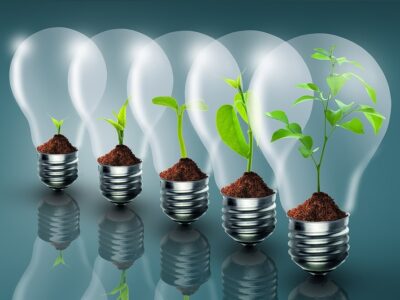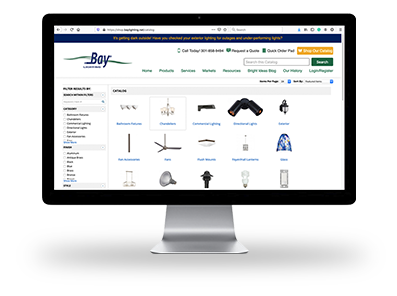Blog
- Home
- Resources
- Bright Ideas Blog
- Earth Day: A Guide to Recycling in the Commercial Lighting Industry
Earth Day: A Guide to Recycling in the Commercial Lighting Industry

Earth Day is the perfect opportunity for commercial property owners to think about their recycling efforts and carbon footprints. Proper light fixture recycling is not only good for the environment, but for some bulbs, it is required by law. Incandescent bulbs, halogens, LEDs, and fluorescent should all be recycled responsibly to avoid environmental contamination. A local commercial lighting company can help you practice responsible lighting recycling and contribute to a cleaner world.
Benefits of Recycling
Making an effort to incorporate sustainable and environmentally-conscious practices reflects positively on any business. Working with a commercial lighting recycling company is an easy way to improve your company’s image while simultaneously making a positive impact.
According to the Environmental Protection Agency, recyclable materials make up a significant amont of the contents of landfills in the United States. In fact, about 13.1% of landfill waste is plastic, 9.9% is metal, and 4.9% is glass.
During the recycling process, bulbs are separated by material (plastic, metal, glass, phosphor powder, elemental mercury). These materials are then used to make all different kinds of new things, contributing significantly to recycling in many industries. For example, glass recycled from lighting fixtures may be used in asphalt for roads to help with the reflection at night.
This allows for the glass to be repurposed for a useful cause that helps both people and the environment.
Landfill Waste
Beyond this, the world’s waste production is increasing constantly. In 2018, landfills received approximately 7.6 million tons of glass waste. Landfill space is running out, and reducing landfill waste is good for the entire planet, because landfills pollute the soil in the areas around them and can leak chemicals into groundwater, which then pollutes the oceans. Pollution in the oceans has a negative effect on the environment overall, so making efforts to prevent it is important for any business.
Recycling Different Lamps and Fixtures
Different light bulbs and lamps are made up of different materials, some of which are more hazardous to the environment than others. Because of this, there are different protocols in place for each type of fixture according to appropriate safety measures. The following different types of lighting require specific eco-friendly recycling efforts:
Fluorescents/CFLs
These bulbs must always be disposed of through a recycling service. In Maryland, for example, it is illegal to throw these bulbs in the regular garbage, as they can break easily and release hazardous materials. There are county-by-county resources available for residential customers but for commercial properties, the easiest and most efficient choice is to partner with a commercial lighting distributor that offers a recycling service. Often, your lighting distributor will schedule a simple pickup of your fluorescents and CFLs at the same time they are delivering an order, eliminating any pick-up charges.
Halogen
Halogen bulbs are not considered hazardous waste as they do not contain mercury. However, they should not be disposed of in a regular recycling can because the fine wires in glass processing are extremely difficult to separate out. They also contain halogen gas, which is not toxic, but further makes recycling a challenge.
Additionally, halogen bulbs are made of quartz glass that melts at a specific temperature and will contaminate other glass items. The easiest and most environmentally-conscious way to dispose of halogen bulbs is to work with a lighting distributor that offers accessible light bulb recycling services. They can ensure your bulbs end up in specialty facilities and can be repurposed appropriately.
Incandescent
These bulbs are also not considered hazardous because they do not contain toxic substances. Incandescent bulbs do, however, require a lot of energy for regular recycling plants to process and are often not considered salvageable. These bulbs also need to be recycled with a specialty recycling service, as they are the least likely to be recyclable for the average facility.
It is legal and permissible to discard these bulbs in the regular garbage. However, the glass is incandescent lighting products is valuable and can be repurposed within the right facility.
LEDs
LEDs do not contain mercury and are the most environmentally-friendly choice for any commercial property owner who wants to reduce their carbon footprint. On average, LEDs use 75% less energy and last up to 25 times longer than other types of bulbs, reducing production energy costs and material waste.
However, LED bulbs and fixtures do contain metals like copper and lead. You may not be required to recycle them in your state, but a commercial lighting recycling service can ensure they reach specialized facilities that can process them. This is the best way to contribute to a greener society through both the use and disposal of LEDs. 95% of an LED light can be recycled, so making the effort to recycle them is a great way to improve your company’s efforts towards sustainability.
Light Fixtures
Old fixtures can also be broken down and sorted for recycling. Once the lamp type has been determined and removed, metal housing, plastic, and glass can be easily be recycled. For turn-key retrofit projects, your lighting specialist will typically dispose of trash and recycle appropriately as part of your service but it’s always a good idea to ask how all waste from your project is handled.
Additional Materials for Recycling
Ballast can also contain harmful materials that can be toxic if not disposed of properly. Ballast components are separated and hazardous materials are disposed of properly and non-hazardous materials are re-used.
Large batteries are also important items to recycle and often found in the lighting industry. In addition to re-using raw materials, batteries have corrosive materials and heavy metals which are harmful if leaked into the environment.
How to Recycle Light Bulbs
In each state, different lighting recycling resources are available. Maryland, D.C., and Virginia commercial property managers can work with Bay Lighting to develop a routine bulb recycling plan and make sure their lighting waste is being disposed of properly.
Bay Lighting partners with a leading provider of environmental solutions to handle our customer’s waste from lighting products. This partnership ensures that we are following best practices and guiding our customers accordingly. Recycling is easy with Bay Lighting. Simply choose an area on your property to dedicate to recycled bulbs and organize lamps in a separate container from ballasts and batteries. Broken lamps cannot be included. Seal your recycling box and schedule a convenient pickup. You can even time your recycling pickup with a new commercial lighting order to cancel out delivery fees. We make it easy for you to make your business more environmentally-friendly and will work with companies of all sizes and types.
Regardless of how many lamps or bulbs you have to recycle, we can help. Estimate your per pound price now, based on your quantity of bulbs, using our recycling calculator.
Contact Us
If you are interest in reducing your company’s carbon footprint, Bay Lighting can help. We offer light bulb and lamp recycling services that make it simple and easy to ensure your fixtures do not end up in landfills. We also offer a range of LED upgrades and can help any business reduce energy expenditure by replacing older, energy-inefficient bulbs with modern, quality commercial LEDs. Contact Bay Lighting to learn more or give us a call at 301-858-9494 today.




